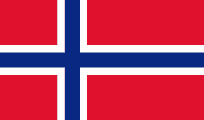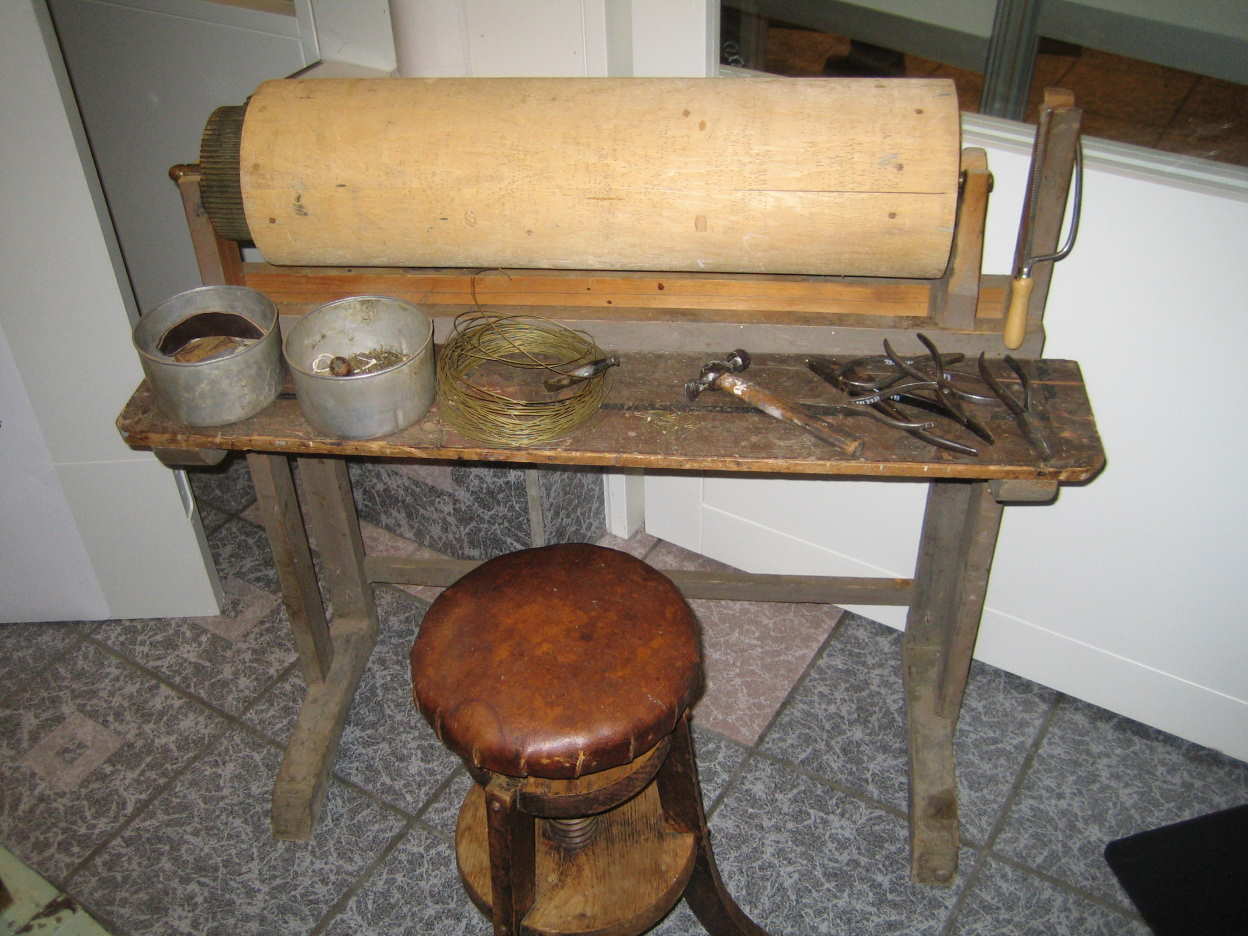Bredesmo-positive that has found its way north in Norway. The positive was built by Jakob Bredesmo, but the build year is not known.
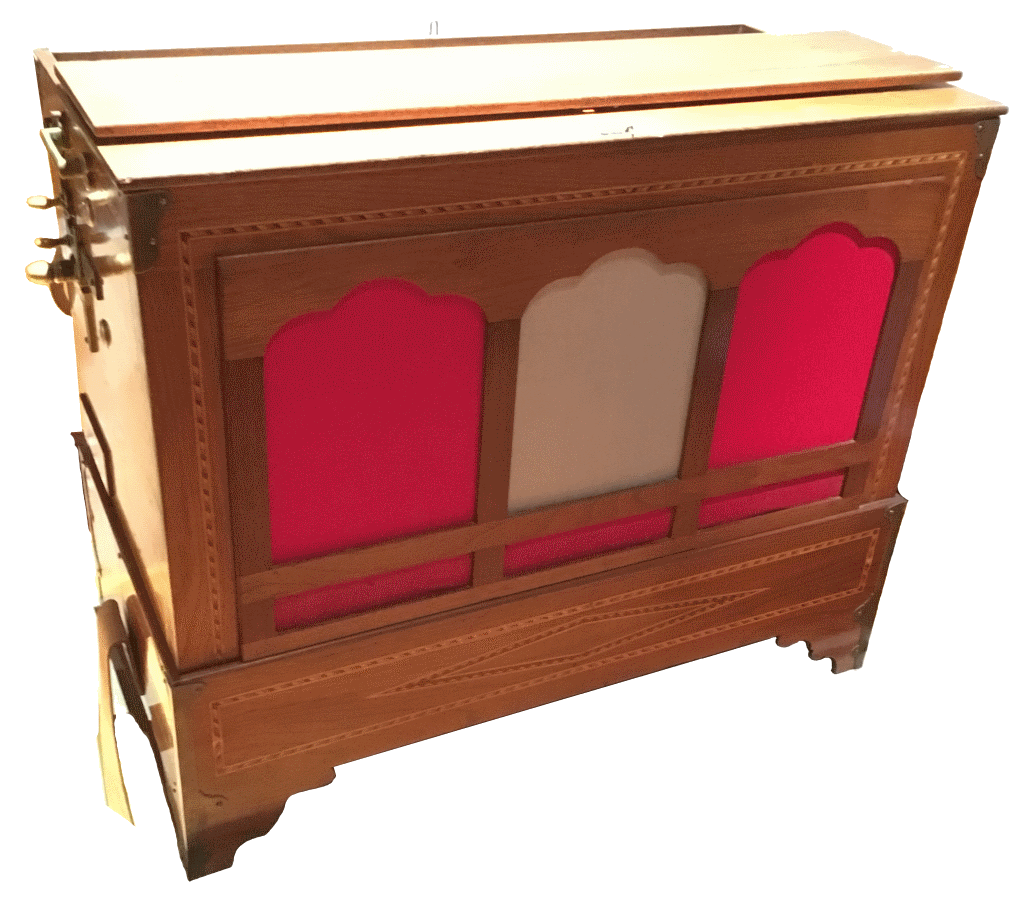
THE POSITIVES
The widespread Steinkjerpositives,
a register over the preserved.
The Steinkjerpositives were built by several instrument makers over a period of 60 years. Tharaldsen built most of them, and they were standardized in three sizes, 22, 25 and 28 keys. These were named in Norwegian as the "little" ("Litjspælle"), "middle" ("Mellomspælle") and the "large" ("Storspælle"). Due to the relatively great number of instrument makers, Steinkjerpositives with, 22, 23, 24, 25 and 28 keys have been found. They are all built over the same pattern and are relatively similar in design. Decor and building materials vary from simple painted instruments in pine, to beautiful furniture-like ones in polished mahogany with intarsia inlays.
Structure and materials.
The Steinkjer positives were built by several instrument makers over a long period of time. This is visible in the structure of the instruments, where the oldes and simplest have instrument bodies of pine. Christian Tharaldsen was a very skilled cabinetmaker and when he started building positives in the mid 1860's the instruments became the finest furniture in mahogany with decorative mouldings. Most of the pipes and mechanics are made from pine and goathide. Parts of the pipe needed harder material, and wood from fruittrees, nut trees and mahogany were used. It is common to find the mechanical parts made in iron, but all the instruments Tharaldsen made had metal parts almost entirely made of brass.
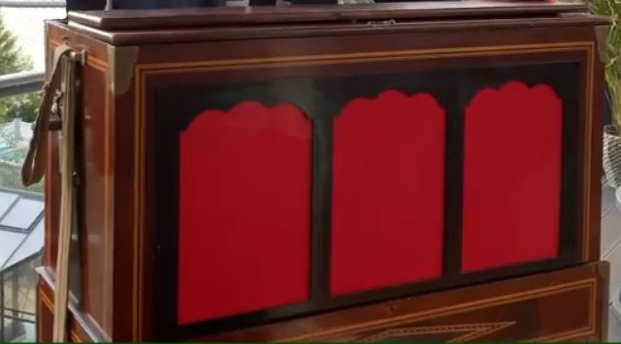
The instruments were mostly made in three sizes, the "little" with 22 keys, the "middle" with 25 keys, and the "large" with 28. The term keys refers to the same thing as scale tones, as in the number of keys on a piano.
A Steinkjerpositiv consists mainly of a group of components. There is a barrel with the pins, representing the tune to be played, and it operates the mechanics. There are two air bellows that pump the air and a reservoir bellows creating even pressure. The reservoir delivers air to several rack of pipes. Valves are mounted in what is called the windchest, and the entire device is assembled into a relative compact wooden case.
Open the section below, to read more about the instrument construction in detail.
The barrel
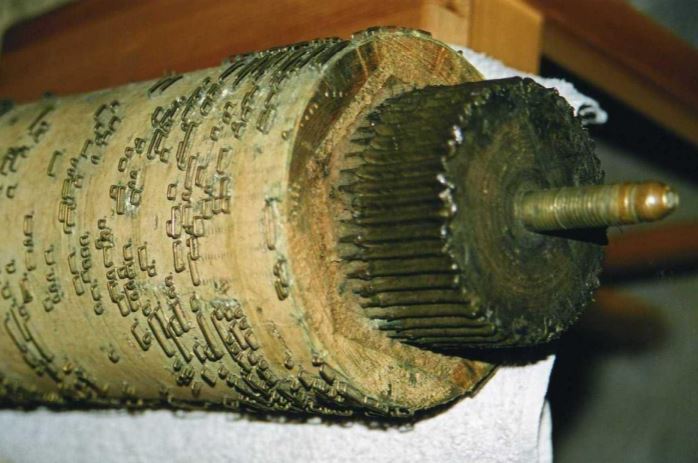
The barrel is made of wood, and is placed in the top and back of the instrument casing. In a Steinkjerpositiv, the barrel is constructed as a set of staves, glued together like a wooden tube. The barrel is hollow, with a glued wooden cap on each side that connect a shaft and a cogwheel, allowing it to rotate when the player rotates a crank. The wooden tube is cut on a lathe into a cylindrical barrel, and since it is hollow, it is lightweight and resistant to cracking. The surface is papered to make it smooth and even. This was often paper with a green or a light brown color. The barrel is pinned with pins and bridges of brass. Pins for short tones, and bridges for long one. The pins are approximately 5 millimeters high, made of 1 mm brass which have been stretched and rolled flat. The barrel's axle has 13 or 14 grooves at approximately 1.7 mm distance. By moving the barrel 1.7 mm to the side, a new track and a new melody can be played. The barrel is locked into place by using a mechanism called "the knife" which slots into one of the 14 grooves. The barrel's circumference and length are specific to the size of the positiv. The smallest positives had a circumference which were smaller than the two larger positives. Played at normal speed this gave around 35 seconds before the barrel had completed one turn. For the middle and the large sizes, the circumference was bigger and the length was increased. The greater length accomodated the additional number of pipes. The increase in radius allowed a longer time for a revolution of the barrel, between 45 and 60 seconds.
The mechanics
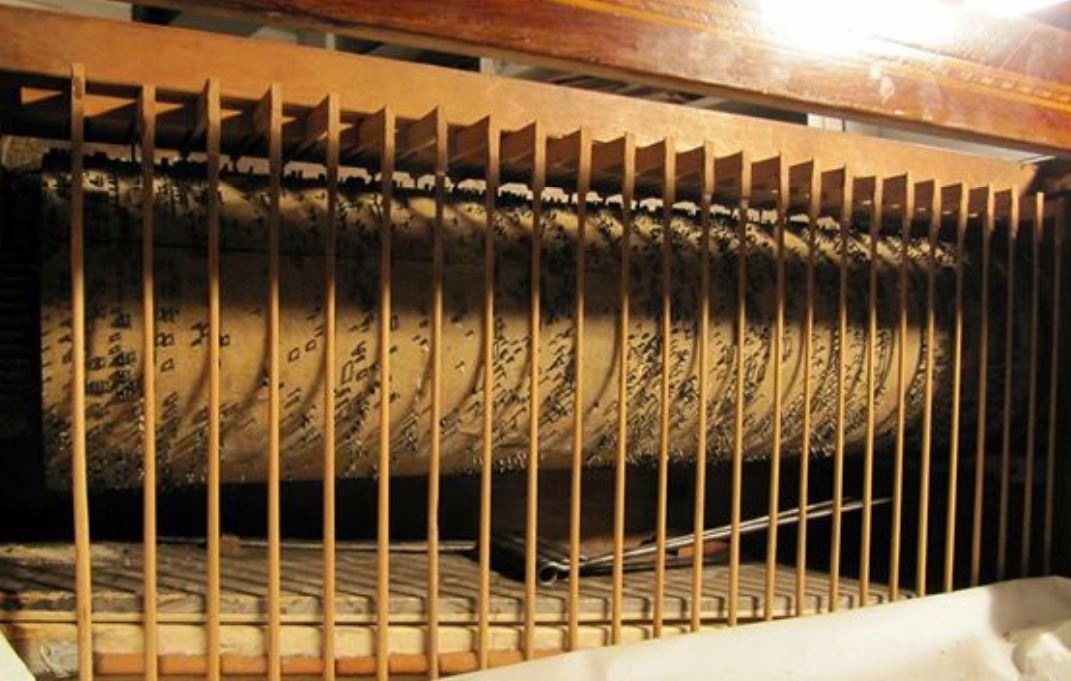
The mechanics are all the moving parts controlling the valves in the windchest, and the hand crank which sets all the moving parts in motion. In the top of the steinkjerpositives, there is a beam with tappets or keys. These are lifted by the pins on the barrel as they pass underneath the tappets when the instrument is played. When a pin engages a tappet it lifts it around 5mm, and on the opposite side a pushrod slides into the windchest to operate a valve, admitting air to the pipe that plays the corresponding note. The tappets are separated approximately 22 mm, and the length of each tappet is around 10 cm. The beam with the tappets is held down by two springs, since it needs to be lifted for the barrel to be removed sideways out of the case. The beam's height can be adjusted using a screw on each side in order to set the correct height of around 1mm between the tappets and the pins in the barrel. The barrel rotates with the aid of a crank as a part of a worm and gear arrangement. The worm and gear rotates the barrel, and the crank operates the double-acting bellows pumps. The pipes are arranged in registers or ranks, with a coupler as a part of the windchest to open or cancel the air to a rank of pipes as in an ordinary pipe organ. The player determines which rank of pipes will play by pushing or pulling these couplers. Each coupler has holes which match the holes in the windchest, allowing or stopping air to the pipes.
Pipes
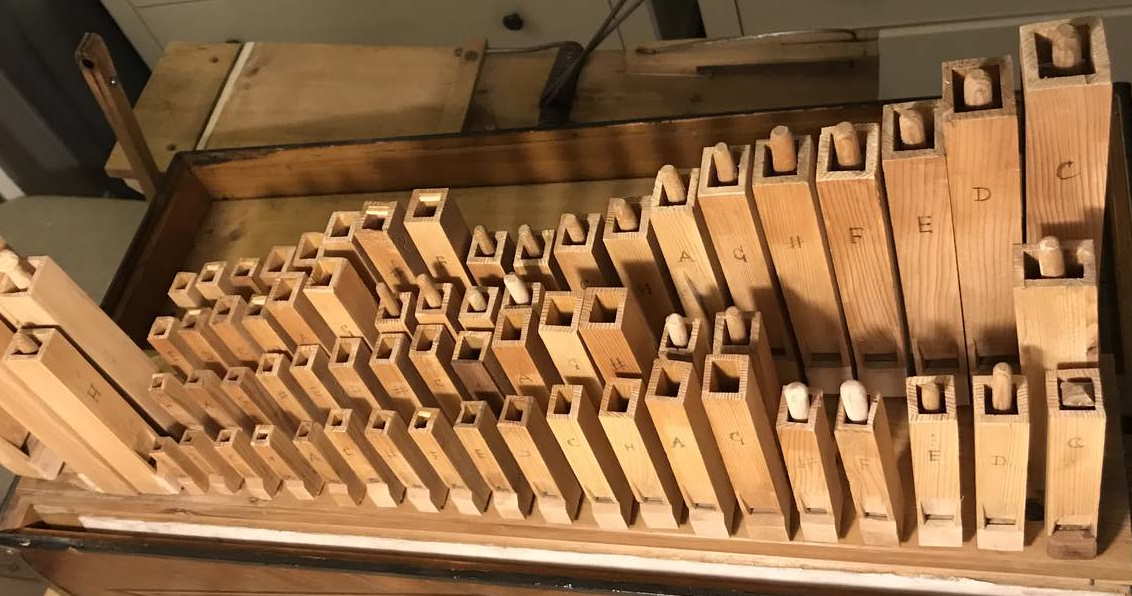
The pipes create the sound in the positive. Most of the pipes are placed in racks on top of the windchest. The deepest 8 inch voice needs more space, and is located under the bottom plate of the instrument. Across in the top is the deepest of the 8 inch pipes, across above the other pipes. Inside the instrument housing, pipes are located in racks, or registers. It is common for the smallest instruments to have couplers only for the internal pipes, leaving the rack underneath to always be connected to the airstream. The internal pipes can be coupled in and out in order to vary the sound according to music played. Inside the case, against the player, there is usually a rack of 4 inch pipes. It is common for the racks outwards to consist of a 2⅔ inch and 2 inch pipes. For the largest instruments, also a 1⅗ inch voice is normal. Because of the limited space inside the case, each rack can often have covered pipes towards the highest tones. The pipes are made from wood. The fronts, at the fipple, where the air is split, are of hard wood such as birch or fruit trees. The remaining parts of the pipes are from pine.
Bellows
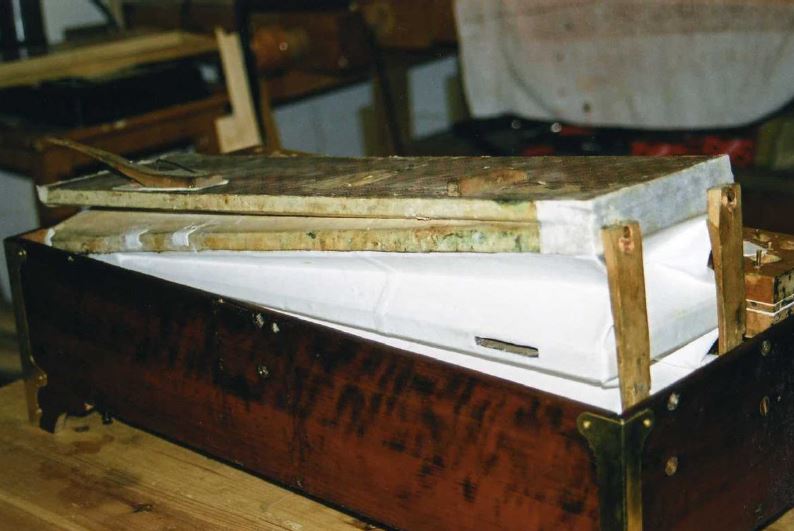
The air in a Steinkjerpositiv is made by to wedge-shaped pumps - a double-acting bellows. It is built in such a way that it pumps air both when lifted and when pushed down. The bellows construction includes a magazine or reservoir bellows on the top, with a spring loaded pressure valve which does not open until the reservoir is full. The reservoir bellows is compressed using two metal springs, and in that fashion an even flow of air is produced to the pipes. A Steinkjerpositive plays with wind equivalent to a column of water varied from 80 to 115 mm. The largest instruments work at a more even pressure than the smallest ones, due to the bellows size.
Windchest
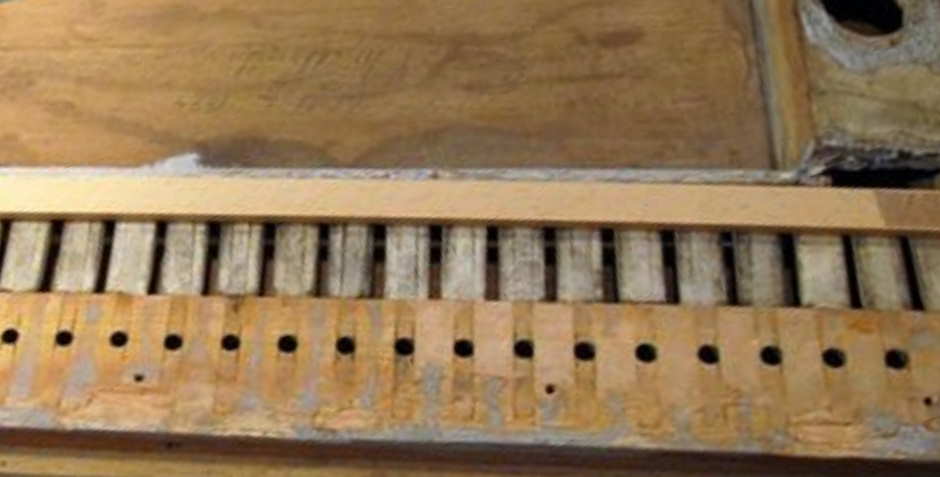
The pipes are arranged on top of the windchest which contains the valves, one per note, and the register stops. In the Steinkjerpositives the windchest also a contains the couplers. The couplers is as the name suggest, and coupler for each rack of pipes. This means that all pipes which belong to the same soundtype, gets the air from the same coupler. The couplers are made from one piece of wood, in old-fashioned organ building traditions. If the instrument has 23 tones, the coupler have 23 tracks, one for each of set of similar tuned pipes.
Casing
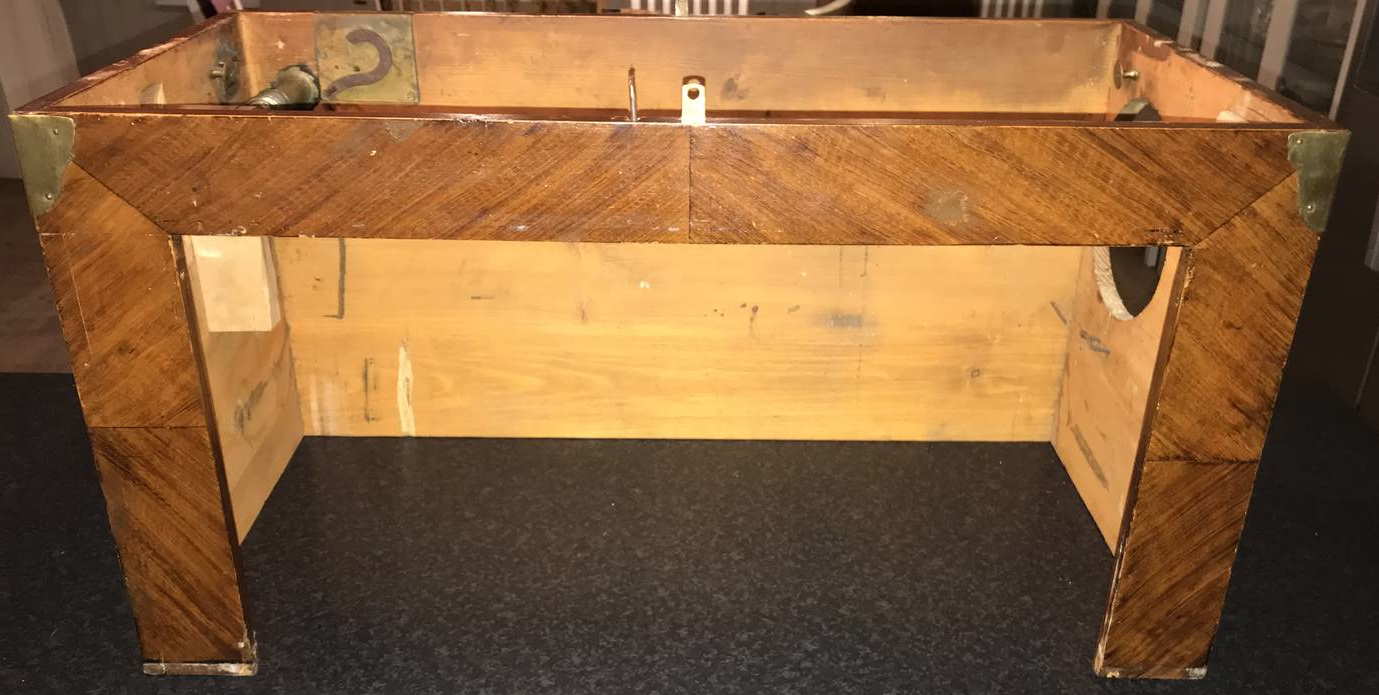
The instrument body has the function of protecting the pipes and the mechanics from external wear, weather and wind. It doubles as a organ house which collects the sound. The housing of the finest Steinkjerpositives was made of mahogany and walnut, while the simplest had a housing of pine, either painted or veneered on the outer side. Hardwood was expensive, but was used on later instruments to a large extent. On one side of the housing, a lid could be removed, in order to change the barrel.
A database over preserved
positives.
The Steinkjerpositives were spread by windjammer sailboat trade to a great area, in particular to the north of Norway. Several positives have from there wandered to north of Sweden and Finland. There is also documentation of positives in Denmark, England and in the Netherlands. A lot of instruments found their way to America as goods traveling with the ones emigrating. In this database there are sound examples and pictures for each positive in addition to a short description.
Database:
Bredesmo
Ukjent
---
The instrument was built by Bredesmo in the 1870s, and is today owned by Snåsa Bygdemuseum.
It is said that Jacob "prepared" this positive to Sivert Strinda (Strindmoen) and it is therefore natural to say that this positive was a joint venture between Jacob and Sivert. The positive ended up in Lorents Vinje's possession. He lived in Viosen and many have danced to this instrument with Vinje as player. When Vinje's wife died, she had decided in her will that the instrument should belong to a future museum in Snåsa.
Snåsa
---
This Bredesmo positive is located in Otta, and is owned today by a family who bought it in the 1990s.
The positive originally came from Mosjøen, but was bought to Løkken after the war. The positive was used there for functions as late as 1960. The positive has been restored in recent years, the pictures show the positive as it looks today and how it looked before restoration.
The positive has many markings about repairs, the first time in 1878 in the Mosjøen. The positive has been repaired several times, before it was finally restored in Levanger.
Otta
Fosnæs
The positive was probably built before 1856, based on the information from the other known Steinkjer positives that Thomas Fosnæs has built. It is therefore listed with an assumed construction year of 1850, without having been found written somewhere in the positive. The instrument was originally owned by Annæus Myklevand, and when he traveled from Trøndelag he had with him a positive made by Fosnæs from Beitstad. This positive was sold at auction after Annæus died, the heirs of deceased buyers wanted it to go to Steinkjer And it finally ended up in Steinkjer Museumslag's possession in 2017.
Under the lid it is written with blå pencil: "No, 15 manufactured by T. Fosnes Roster rustad" and "Awarded with Medal of the Industrial Exhibition in Stenkjær Kro: 120"
Steinkjer
---
This positive was built by Thomas Fosnæs in 1856 after he moved to Steinkjer. The positivet is one of the oldest preserved instruments from Steinkjer, and must be considered the origin of the large positive-production that took place from around 1860 to 1910. The instrument is owned by a family from Mo i Rana today.
Mo i Rana
Schjefte
This is a children's positive that Jacob Schjefte made for his grandson, Oscar Ramstad when he was 5 years old. The positive has 8 melodies and has 18 closed pipes. When Oscar Ramstad traveled to America as an adult, the positive remained at Innherred. It was at Malm to his brother Jacob for many years, Oscar thought that the positive was lost, but when the family came into contact with each other, so then he would like to have it sent later. The positive was repaired and sent over, and remained on display in the family's music store for several years. After Oscar died, the son took over the instrument, and after a while it ended up in the Ringve museum. The recording of the instrument on the positive was made before the instrument was sent to America.
Trondheim
---
The instrument was built and signed by Jacob Skjefte in 1899, 125 pipes, 25 notes, 5 choirs. Now owned by a collector in England, who has had Midi installed in the instrument without changing the structure, and it should be according to what is been told to be easy to remove without marks. The positive has a powerful sound and has music that was typical of the time for the later positives from Steinkjer.
Northampton England
Tharaldsen
A positive built by Tharaldsen, the instrument has 3 barrels with melodies. The positive was restored a number of years ago, and is today privately owned in Mosjøen. The box on this positive lacks the usual "rhombus motif" which are common on most other Tharaldsen instruments. Barrel number 3 is back-ordered, and was made for the instrument in 1901 by Jacob Schjefte.
Mosjøen
---
The positive is located in Mosjøen and is marked with production number 20
It has 80 pipes 22 tones, 10 melodies, 4 stops. Has belonged to Lofoten and several other places after it was taken north in a Jekt in 1867.
Mosjøen
---
This Tharaldsen positive was built in 1870 and is located in Steinkjer. It was owned by three siblings in Harstad, bought by their grandfather in the 1930s, more specifically at Nils A. Øybakken's music store.
The positive is marked "tuned by Øybakken in 1918", has three Barrels, a total of 36 melodies.< The positive is marked "tuned by Øybakken in 1918". After having repaired quite a few instruments, he became known to be very skilled.
Steinkjer
---
Positively built by Tharaldsen, signed with 1871 under the bellows.
The game has been restored some time ago, and a new bellows has been fitted. It is marked with a signature from 1871, the largest pipe is marked with Tharaldsen's medal marking from 1887, and inscribed with the year 1873. It is assumed that the bass pipe was re-ordered later, and marked with the wrong year of manufacture. The instrument has been marked as repaired by G. Mulau Kirkenes on 8 August 1929. The instrument has a pin barrel with 13 melodies, which Schjefte probably made. The instrument is functional and has been repaired due to wind leakage in recent years.
During the life of the instrument, the case has been sanded and varnished dark brown. The rhombus motif on the front is visible under the shellac. In 1871, the positive was sent north with a jekt, and eventually ended up as far north as Kirkenes. From there the game was exported to Sweden. It was bought back to Norway by the current owner from Umeå who brought it back to Steinkjer in 2019.
Steinkjer
---
A Tharaldsen positive from 1873 in good condition. The instrument has been restored on several occasions and plays well. This is a so-called "mellomspæll" with 25 tones, and with melodies with 45 seconds length. The barrel is pinned as usual as other positives from the same period, with waltz, reinlender, mazurka, gallop and a march.
Herøy
---
The largest pipe is marked with Christian Tharaldsen 1874. Built as a standard 25 tones positive with 5 registers in a gray painted transport case. Mark repaired 1987, Torkildsen Åsen. Torkildsen found the following written on the bellows plate: "Belongs to me Egil Marken, Vefsn"
Marked with: "Repaired several places, as well as new Hevestang by N.A.A.V on 11/12 1912".
"Renovated and worked new side in January and February 1921 by Torgeir Svenskvold".
Marked with: "repaired and stamped on 10-6-1944 - Harald Øybakken, Mosjøen"
Handwritten under the cover "Worked in 1974 by C Tharaldsen ved Stenkjær"
Sparbu
---
Positive built by Tharaldsen in 1875, the instrument has two barrels, one of which must have been made as late as 1920, given the two melodies which are on it. One is reinlender "Du skal få sukkertøy og du skal få lade" which was composed by the accordionist Hans Eriksen in 1913. Another hit is "Livet på Finnskogarna" which was composed by Carl Jularbo who lived from 1893 to 1966. Barrel number two is by this believed to have been made around 1920. Barrel number 1 is believed to have been delivered with the instrument in 1875.
Oslo
---
This is a Tharaldsen positive from 1877, which belong to the Kile collection. It is now in the Vest Agder Museum, which has a total of 4 Steinkjer positives. The positive is made of polished mahogany, with inlaid intarsia decoration in the form of a border. It has three sound openings with red fabric.
The positive has 22 notes, 4 voices and 3 register movements, and is thus a typical "Litjspæll.
Vest Agder Museet
---
This is a Tharaldsen positive from 1877 and is owned by the Vest Agder museum.
This is one of four Steinkjer positives in the Kile Collection that the museum acquired.
Trygve Kile in Holum outside Mandal brought the four Steinkjer positives to Southern Norway. He traveled both in Norway and other countries to buy up mechanical instruments.
This positive is in good playable condition and is used on several occasions under the arrangements of the museum.
Vest Agder Museet
---
Positive built by Tharaldsen from 1877, with 22 tones, and 4 registers. The lower one is open all the time, while you can choose to enter each of the upper registers with three register stops on the side.
Ukjent
---
A Tharaldsen positive in good condition. Has been owned by the same family in Roan from 1917 to 2020. The current owner bought the positive at auction and it is now in Selbu.
Selbu
---
This is a Tharaldsen positive from 1878, with three barrels. The instrument is located in Snåsa. The positive is an "mellomspæll" with 25 notes and 4 stops, and it is equipped with two barrels. When Otto Nielsen made a radio program about the Steinkjer positives, this was one of the positives that was mentioned.
Snåsa
---
This positive is owned by Steinkjer Kommune.
The positive was bought from Namsos by the head of culture in 1988, and has been restored to good playable condition in the 1990s.
The positive has a gray painted transport case and has been stored at the Egge Museum afterwards. The positive is regularly used at various events and is a familiar sight in the cityscape of Steinkjer.
Steinkjer
---
Tharaldsen 1880 - today owned by Ringve Museum. The instrument has a total of 109 pipes and is part of the exhibitions at Ringve. The case is made of mahogany veneered spruce with intarsia borders in lighter wood. Tharaldsen had his own technique for making these borders with different types of wood glued together to form decorative moldings embedded in the boxes. On the front of the plinth is a diamond-shaped field in a frame of dark and light wood. Strong brass fittings in all four corners of the plinth and case.
Trondheim
---
This Tharaldsen positive is located at Gildeskål, and has been restored in recent times. The positive has 25 tones, 5 registers where all have stops. The positive was in poor condition before it was restored. The case is mahogany veneered spruce, and much of the veneer was missing. The restoration has been carried out so that the positive looks as if it is new, missing pipes and details have been recreated and fitted into the positive.
Gildeskål
---
This Tharaldsen positive is located in Reading, England, and is awaiting restoration. Today's owner says it doesn't seem to have been touched since it was made. The positive is a typical "Litsjspæll", which is in complete and in reasonably good unrestored condition. The recordings shows that this instrument still needs some work before it plays the melodies that were pinnet to the barrel in 1885 as it was intended to.
Reading England
---
Tharaldsen instrument believed to have been produced in 1886, slightly atypical with 22 pipes. The positive is located at Verdal, and is in non-playing condition.
Verdal
---
Steinkjerpositiv made by Christian Tharaldsen in 1886, is today owned by the Egge Museum and is used a lot at events organized by the Museum. The positive is in a lot of use at events in the municipality, and can always be found at Eggebogen quay when there is a boat and jekt-day. The positive has been restored and appears today as a good sounding instrument that always catches the eye.
This positive has build number 305, and has three barrels. The instrument plays extremely well, and is a very well preserved example.
The melody which is marked with [3-1] was recorded in Steinkjer Church, gives a very good impression of the performance on this positive. The recording was made during a presentation of the Steinkjer positives together with the newly restored organ that the church has. Without certainty, this may probably be the first time that Steinkjerpositiv was played in the church.
Steinkjer
---
The positive was built by Tharaldsen in 1887, and is located in Steinkjer. It did originally come from Mo i Rana, but returned to Steinkjer in 2021. The positive has been undergoing restoration for the past two years as there was a lot of damage when the positive had been exposed to dry humidity for a long time. The positive has two barrels, one marked with No.1 and the other with No.2. Both barrels are pinned the same way, with 5 waltzes, 2 mazurkas, 1 pols, 2 reinlender and 4 polkas/gallops. The reinlender on both barrels are known in local folk music tradition. Reinlender (number 10) on barrel 1 is known as "Reinlender after Odin Oksås", while Reinlender (number 10) on barrel 2 is one of the better Reinlenders after Hilmar Aleksandersen known as "Reinlender from Trøndelag". Pols (number 8) on barrel 2 is known in local tradition from Verdal, while Pols (number 8) on barrel 1 is an unknown pols dance.
Steinkjer
---
The positive is in a slightly atypical Tharaldsen style and has only two register stops, the instrument has 12 melodies of 22 notes. The bass pipe is marked with Chr Tharaldsen Instrumentmager, Steinkjer. The year of construction is almost blurred, but it may look like there is a faint seven at the end, written in pencil. We have seen on several occasions that positive owners have re-ordered spare parts for their positives. The case itself may appear to be from the years between 1866 to 1870. Perhaps this positive has an older construction year than the marking on the bass pipe?
Glouchestershire England
---
This Tharaldsen positive with 28 tones, is one of the few large positives available. It is located in the Mosjøen. The positive has a black-painted box, and is used for functions with dancing.
The large positive, or "Storspællet" as Tharaldsen himself called them, are easy to recognize by the fact that the portal in the middle of the positive is "double". The box is larger on these positives, to make room for 28 pipes in width.
Mosjøen
---
Tharaldsenposisiv owned by the Nordlandsmuseum, recently restored. The case is mahogany veneered spruce, where the mahogany veneer had loosened a little, especially towards the bottom of the positive. The positive was otherwise both complete and in fairly good condition before it was returned to a playing positive. Most of the restoration work was done in the valve mechanism in the wind chest, when several of the springs were tightened or replaced.
Nordlandsmuseet
---
A positiv built by Tharaldsen in 1892, bought in 1964 from Hamarøy to the current owner in Mo i Rana. The family has restored the instrument to the state it is in today, with good sound and a good tuning. The positive has two barrels, where number one is easier to play as there is a little more opening between the pins so that the melodies are easier to hear. Barrel number one may indicate that it was created by Schjefte, since it starts with 4 waltzes as standard before it became both mazurka, polka and reinlender, and as usual the roll ends with a march. Barrel number two contains well-known melodies from older Tharaldsen positives, all the way back to 1871.
Mo i Rana
---
This Tharaldsen-positive from 1893 is in the USA on display in the Musical Instrument Museum in Phoenix, Arizona. This is an "Mellomsp%arlig;ll" which shows that many who emigrated to America chose to take their instruments with them, either because they were considered to be valuable, or because there was a desire to bring along music from the homeland.
Phoenix USA
---
The positive is located in Namsos - The positive has been on Spitsbergen for a period after it was built by Christian Tharaldsen in 1893. The positive is one of the few remaining 28 tone "Storspæll" Today. The instrument is more to be considered a mechanical organ, than a streetorgan, since it takes two people to carry it.
What is special about this instrument is that it plays a famous song composed in 1892, "After the ball" composed by Charles K. Harris in 1892. [1-2] This song became quickly popular, and came to Norway within a year, and found its way to a Steinkjerpositiv in a years time. This melody was first ordered especially for a barrel that was delivered to Johan Bøe from Vega.
This instrument is recordet as build number 331, and was thus built in the last decade Tharaldsen was active. The oldest known Tharaldsen positive is from 1898. If you compare the sound of this one, compared to the earliest positives from 1866, you observer and hear the development that was made both in appearance and in performance. The sound from this positive is fully on par with other mechanical organs from the same period.
Namsos
---
This positive is built by Tharaldsen in 1895, it is marked with repaired 1913. The instrument has been in the same owner's family since it was bought in 1895, and is for this reason a very nice instrument in its original design. The wood has dried up a bit in the 125 years since the it was made, without this resulting in cracks or dents in either the case or the instrument itself. The positive has three Barrels, where the two extra barrels are each in their own grey-painted wooden box.
Steinkjer
---
This Tharaldsen positive is privately owned in Mosjøen. The instrument comes from the collection after Bergstein. The instrument is an "mellomspæll" with 25 pipes, 5 registers and it has two barrels. The positive is a beautiful instrument that is in good playable condition.
Mosjøen
---
Tharaldsenpositiv owned by Levanger Bymuseum. The instruemtn was restored in 1992. It has 25 tones.
Levanger
---
Tharaldsen positive with 25 tones located in Brønnøysund. The positive has been restored by Jann Magnar Fiskvik
Brønnøysund
---
This Tharaldsen positive from 1898 has been recently restored and is located in Eidsvoll where it is used a lot. The positive is an "Mellomspæll&qout;, with 14 melodies on the barrels. The instrument is a good example of how beautiful these last instruments Tharaldsen made were. The boxes are made of polished mahogany, decorated with Tharaldsen's trademark, inlays of intarsia norders and brass fittings, as functional decoration in the box.
Eidsvoll
---
On the second floor of the main building at Ringve Musikkmuseum in Trondheim is one of the positives made by Christian Tharaldsen in Steinkjer located. The instrument is marked with number, name and stamp. This "mellomspillet" was made in Steinkjer in 1898. If you visit Ringve, then perhaps you can ask the tour host to play a melody for you.
Trondheim
Tveraas
A positive which was built by Peter and Odin Tveraas, and given to Steinkjer Museum. The positive was given as a gift to the museum from Kristoffer Langnæs and was in playable condition when it arrived at the museum. Unfortunately, the instrument were lost in the fire in Klæbustua on Nordsihaugen in 1993.
Steinkjer
• Åse Mørk - Fra steinkjerpositiv til elektronisk lirekasse, Høgskolen i Telemark 2014.
• Bjørn Alexander Bratberg, Steinkjerpositivet, et trøndersk bidrag til lirekassetradisjonen. Hovedfagsoppgave NTNU - 1996.
• Charles Karlsen - Essays and newspaper articles.
• Jann-Magnar Fiskvik - Restorationreposts of steinkjerpositives.
• Harald Sakshaug - Character descriptions and mapping of the positivmakers in the Innherred part of the middle of Norway.
• English language spelling correction and language improvement - Peter Neilson, North Carolina.
